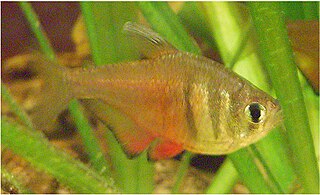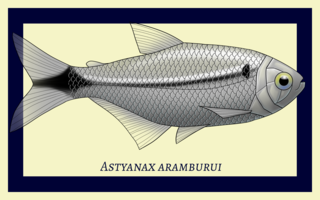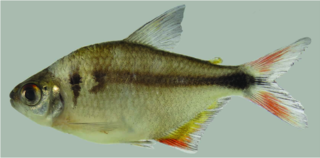
Characidae, the characids or characins, is a family of freshwater subtropical and tropical fish belonging to the order Characiformes. The name "characins" is an historical one, but scientists today tend to prefer "characids" to reflect their status as a, by and large, monophyletic group. To arrive there, this family has undergone much systematic and taxonomic change. Among those fishes remaining in the Characidae currently are the tetras, comprising the very similar genera Hemigrammus and Hyphessobrycon, as well as a few related forms, such as the cave and neon tetras. Fish of this family are important as food in several regions, and also constitute a large percentage of captive freshwater aquarium fish species.

Tetra is the common name of many small freshwater characiform fishes. Tetras come from Africa, Central America, and South America, belonging to the biological family Characidae and to its former subfamilies Alestidae and Lebiasinidae. The Characidae are distinguished from other fish by the presence of a small adipose fin between the dorsal and caudal fins. Many of these, such as the neon tetra, are brightly colored and easy to keep in captivity. Consequently, they are extremely popular for home aquaria.

Hyphessobrycon is a genus of freshwater fish in the family Characidae. These species are among the fishes known as tetras. The genus is distributed in the Neotropical realm from southern Mexico to Río de la Plata in Argentina. Many of these species are native to South America; about six species are from Central America and a single species, H. compressus is from southern Mexico.

Astyanax is a genus of freshwater fish in the family Characidae of the order Characiformes. Some of these fish, like many of their relatives, are kept as aquarium pets and known collectively as tetras. With around 150 described species and new ones being described yearly, this genus is among the largest of the entire order; Hyphessobrycon also has more than 145 species and which one is larger at any one time depends on whether more species have been recently described in one or the other. The blind and colorless cave tetra of Mexico is a famous member of the genus, but its taxonomic position is disputed: Some recognize it as part of the Mexican tetra and this is supported by phylogenetic evidence, but others recognize the cave form as a separate species, A. jordani.

The flame tetra, also known as the red tetra or Rio tetra, is a small freshwater fish of the characin family Characidae. This tetra was first introduced as aquarium fish in 1920 by C. Bruening, Hamburg, Germany, and formally described in 1924 by Dr. George S. Myers. Today large numbers are bred in captivity and it is common in the aquarium trade, but the remaining wild population in Southeast Brazil is highly threatened.
Astyanax microschemos is a species of characid fish from Brazil. It belongs to the A. scabripinnis species complex and differs from other species outside it by having a lower number of branched anal fin rays and its shallow body depth being about 26.9-29.7 vs more than 35% of its standard length (SL). Compared to species of its own complex, it can be distinguished by the combination of its shallow body depth, and smaller interorbital width. The species name comes from the Greek mikroschemos, meaning "low stature", which refers to the shallow body depth of the animal.

Deuterodon pelecus is a species of characid fish from Brazil. It can be distinguished from other species by: its body depth ; its short and pointed snout smaller than the orbital diameter; and a reduced number of branched anal fin rays. D. pelecus also differs from members of its genus by its characteristic color pattern. It possesses a single humeral spot that is constricted to the region above the lateral line; at the same time it shows a conspicuous midlateral body stripe from opercle to the caudal fin base, an autapomorphy of this precise species. Other Deuterodon species have a humeral spot that is vertically or horizontally elongate and have the midlateral stripe becoming faint near that humeral spot. The species name is derived from the Greek pelekus, meaning "axe", referring to the pigmentation shape resulting from the adjoinment of the humeral spot with the midlateral stripe.

Carlastyanax aurocaudatus is a small species of freshwater fish in the family Characidae native to the Río Cauca in Colombia. It is the only member of the monotypic genus Carlastyanax, which was named in 1972 specifically for the species by Jacques Géry. Upon description, it was named Astyanax aurocaudatus by Carl H. Eigenmann. There has been debate concerning whether or not the genus should be recognized, but C. aurocaudatus is currently considered a valid species.

Astyanax altiparanae, sometimes called the yellow-tail tetra or yellow-tail lambari, is a species of schooling freshwater fish widely distributed across the southern half of South America. It is an ecologically flexible species, able to adapt to various resource and space conditions, and its diet follows this pattern; it is considered opportunistic and omnivorous. Its widespread nature and unspecified ecology contribute to its status as a species of least concern on the IUCN Red List. It was originally described from the upper Paraná river basin, which is the origin of its specific epithet; "alto" means "higher" in Brazilian Portuguese, hence "alto Paraná".

Astyanax aramburui is a small freshwater fish from the rivers of South America, restricted to a relatively small region within the Paraná and Uruguay river basins of Argentina. It was named after the scientist who established a professional presence for ichthyology in the country, Raúl Arámburu. Considered a near-threatened species by the IUCN, its range includes creeks in a sub-basin affected by various forms of pollution.

Astyanax bacalarensis, sometimes referred to as the Bacalar tetra, is a small species of freshwater fish found in Central and South America. Its scientific and common names both refer to its type locality, Lake Bacalar in Mexico, and it further inhabits freshwater environments like cenotes, streams, and wetlands. Its widespread nature, paired with an omnivorous diet, make it a hardy species.

Astyanax bagual is a small species of freshwater fish known only from the Taquari-Antas river basin in southern Brazil. It is unusual in the genus Astyanax because mature male specimens display bony hooks on the rays of all fins; in opposition, most others have them on the anal, pelvic, or pectoral fins - sometimes on more than one of these, but very rarely on all fins. It can further be told apart from various congeners by way of dentition and some aspects of coloration, including the presence of two humeral spots instead of one.

The twospot astyanax, also called the two-spot tetra, is a small species of freshwater fish native to South America. It is a middlingly common tetra in the aquarium industry, with hobbyist reports of its sale and presence, and it is also a well-studied member of the genus Astyanax in wild settings. Amateur aquarists report peaceful schooling behavior in captivity, though fish in wild schools may turn on one another if presented with the threat of a predatory species.

Astyanax biotae is a small species of freshwater fish native to various localities in Brazil. It primarily eats invertebrates, like copepods and aquatic fly larvae, and its diet also includes seeds, fruits, and filamentous algae. Its scales are largely silver, with a touch of yellow-brown on the back and a hint of blue on the sides. Like many species of Astyanax, it has a humeral spot, which is a blotch of pigmentation in the area above or around the pectoral fin.

Astyanax bourgeti is a small species of freshwater fish native to the upper Amazon river in Brazil. Originally described in 1908, it is not a particularly well-studied member of the genus Astyanax, but there is enough information available to establish a native range, an appearance, and potential relationships to congeners; for example, A. bourgeti is a known member of the subgenus Poecilurichthys, and has been considered such for most of its existence. Biotope preferences, sympatry, diet, and behavior are all unknown.

Astyanax brachypterygium is a small species of freshwater fish endemic to a collection of high-elevation streams in Brazil. It was named in 2001 alongside congener Astyanax cremnobates, to which it bears a strong resemblance; physical details help to differentiate between the two. Its scales are a greenish-brown on the back and silver on the belly, with reddish fins and a dark humeral spot. One of its defining features is a notably short anal-fin base, which has 13 to 15 rays.
Astyanax bransfordii, sometimes called the longjaw tetra, is a small carnivorous species of fish endemic to a handful of lakes and slow-moving canals in Central America. Its range includes Lake Nicaragua and Lake Managua, which are two of the largest freshwater bodies in Central America; because it occurs only in the relevant areas of Costa Rica and Nicaragua, the area it actually inhabits is somewhat restricted. Its diet largely consists of various invertebrates and smaller fish. This is in contrast to various other species of Astyanax, which are more often omnivorous.

Astyanax brevirhinus is a small species of freshwater fish known only from a river basin in northeastern Brazil. It is somewhat understudied and lacks a conservation status, but it is present in a region that is the subject of an ecological restoration project - the Jequitinhonha River. Specifics of diet and behavior are unknown, though shoaling activity has been observed in laboratory conditions.
Astyanax apiaka is a small freshwater fish endemic to the Apiacá river in Mato Grosso, Brazil. Its discovery is recent, as of 2023, which results in little published research of its natural behaviors or preferred biotopes. However, descriptions of its appearance and general environment have been solidified, as well as some baseline information regarding its diet. It lacks a conservation status from the IUCN.

Astyanax clavitaeniatus is a small species of freshwater fish native to various rivers in the Amazon basin. It is characterized by a club-shaped lateral stripe, which is where it gets its scientific name; "clava" means "club", and "taenia" means "stripe". It is a deep-bodied fish with a silvery base color, which is not uncommon for members of Astyanax. Its markings - including a humeral spot and two vertical brown bars - indicate that it is a part of a species complex centered around congener Astyanax bimaculatus.


















